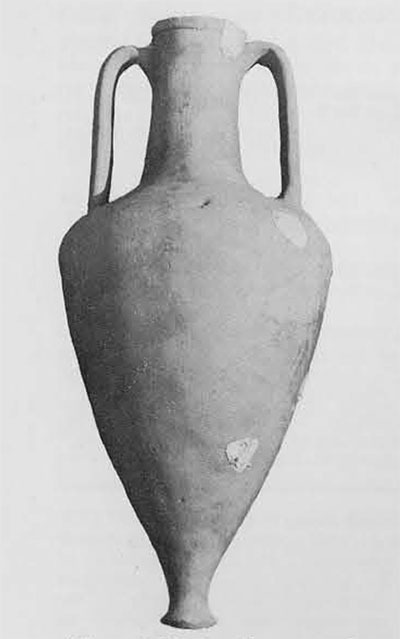
The University Museum underwater excavations in the Straits of Messina were undertaken with a grant from the Geographical Society of Philadelphia. The work was carried out with the permission of the Direzione Generale delle Antichità e Belle Arti and in cooperation with the Soprintendenza alle Antichità delle Calabria.
The director would like to acknowledge the generous help provided by the U.S. Navy Air Support Facility at Sigonella, Sicily, the Comandante Generale dell’Arma dei Carabinicri, Prof. Michael Katzev and the Cyprus Excavation Project, the Ford Foundation, and Mr. and Mrs. Oliver C. Colburn.
Thanks are also due to Prof. G. Foti, Soprintendente alle Antichità delle Calabria, for his splendid cooperation and hospitality and for placing the confiscated objects from the shipwreck at our disposal for study and publication.
And finally, sincerest thanks are due to my dedicated staff without whose hard work the excavation could never have been accomplished. In the best of diving situations, underwater archaeology is difficult and often dangerous; we were diving in the worst.
One of the most urgent problems confronting archaeology today is the continued destruction and looting of archaeological sites. Although land sites have long been ravaged by the voracious looter, with the recent popularization of the aqualung even underwater sites are no longer immune. Remains which have survived for thousands of years are often destroyed in a matter of days, all too often before the authorities can intervene. National and international laws are ineffectual against the organized antiquities smugglers and even when caught the fines are usually insignificant. Occasionally there are situations where justice does triumph and they stand out as glowing examples of what might be done on a larger scale if local authorities assert the limited power at their disposal. Such is the case with the shipwreck recently found in the Straits of Messina, Italy.
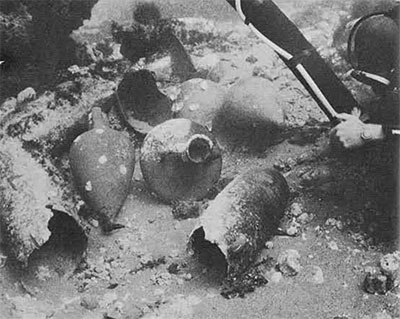
In late November, 1969, I received an urgent appeal from Mr. Franco Colosimo of Catania, Sicily. He wrote that police at Reggio di Calabria had apprehended a group of divers who had been looting a shipwreck in the Straits of Messina and were selling the objects in Italy and abroad. The leader was sentenced to five years in prison for his “crime against the State” and all underwater finds were legally declared national treasures. Mr. Colosimo, who had had previous experience in underwater exploration and excavation in Sicily, was asked to investigate the site. He reported that much of the wreck’s remains had been removed but that in view of the sandy bottom and the unique objects confiscated from the looters, excavation would still be of great value; the fact that many fragments of at least two life-size bronze statues of the late Classical period were found on the wreck was reason enough to undertake a salvage operation. He then initiated contact with Prof. G. Foti, Soprintendente alle Antichità della Calabria, who cordially invited the University Museum to undertake the excavation of the site. With the authorization of the Direzione Generale delle Antichità e Belle Arti and with the cooperation of Prof. Foti, I organized the project.
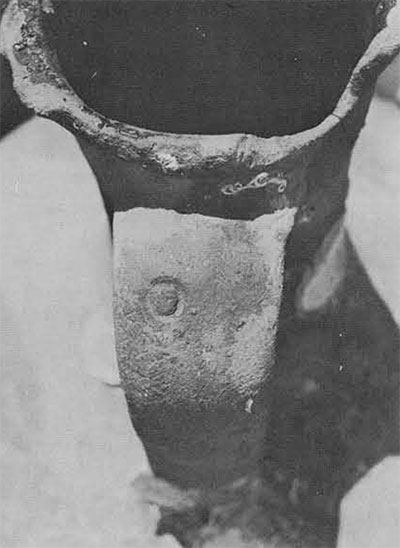
The dangers of diving within the swift currents of the infamous Straits of Messina presented a difficult problem. I decided that only experienced personnel could participate in this excavation. I arranged for a staff of fifteen: six supervisors with whom I had worked previously in University Museum underwater excavations in Turkey and Cyprus, a three-man U.S. Navy diving team stationed at Sigonella, Sicily, five Italian diving carabinieri, and Mr. Colosimo who was appointed foreman in charge of the complicated logistics that underwater excavation entails. Equipment was lent to us by the Cyprus Excavation Project and by the U.S. Navy. The Italian Navy base across the Straits at Messina readily provided us with emergency medical facilities which regrettably had to be used on the second day of diving when one of the staff was successfully treated for a bend. Fortunately it was the only such accident of the season. Work commenced on the Fourth of July, 1970, and lasted four weeks.
The wreck lay on a gentle slope in thirty-seven meters of water about two hundred meters from the north shore of the Straits at the village of Porticello. Living accommodations were provided by a large hotel overlooking the site. On the beach and within the shell of a house destroyed during the Second World War we established a base camp and from this camp conducted all diving operations. Unlike previous underwater excavations, we were unable to work from a fixed barge or diving boat. The treacherous currents and very heavy marine traffic made the use of any fixed craft impossible. Using easily maneuverable rubber boats we motored out to the marker buoys set up over the wreck, tied onto the line and dived from the small boats. With the proximity of the camp to the site this method proved quite efficient in view of the small number of divers; two dives a day were made by each team. Each diver was required to wear an inflatable life-jacket and to swim to and from the wreck while holding tightly to a nylon line tied between the buoy and the wreck. With currents often running at five knots even the slightest slip could have ended in disaster. In spite of these difficulties the excavation proceeded without serious incident.

Following a sketch map of the site provided by the Italian police, we began by conducting a metal detector survey over a 20 x 30 meter area to try to determine the metal concentrations under the sand. Using white string and wooden stakes we laid out one-meter-wide lanes over the wreck area, avoiding the large boulders upon which the wreck had broken up after it sank. The U.S. Navy team followed these lanes with their detector and marked all contacts with wooden stakes to prevent any interference with the very sensitive instruments. All their equipment was non-magnetic to assure the accurate recording of any metal objects in the field of the detector. The contacts were then excavated either by hand or with a portable airlift set up with great difficulty in the swift currents of the Straits. Unfortunately, the pollutants of modern man were evident in most of our contacts; cans, bottle caps, old anchors, wire rope, and even an occasional old shoe turned up in the sandy layer over the wreck. Nevertheless, we were able to locate a wide variety of metal objects of lead, copper, bronze, silver, and iron but not a single fragment of bronze from the statues!
When the metal survey was completed, we selected four areas between the boulders and excavated them down to bedrock. The loose sand overlay was never more than fifty centimeters deep and as a result, with the help of the airlift, we were able to work quickly and efficiently in the twenty-minute diving periods allowed each team. From permanently established fixed points around the wreck we triangulated all finds as they emerged, recording the measurements on plastic slates to be brought to the surface. Because of the strength of the currents on the bottom, areas excavated in the morning were often filled in by the afternoon. Objects had to be measured, recorded, and moved by the diver who found them. Only heavy objects were afforded the .luxury of being photographed in situ. The small and fragile wood fragments that appeared were most difficult to excavate. As soon as the sand was removed from them they would be swept away in the current. It was amazing that any wood survived at all.
In the stern area of the ship and where most of the statue fragments were earlier found, we excavated what must have been the main cabin area. Evidence for life aboard ship was quickly found. A wooden bowl, black-glazed cups, fragments of casseroles and cooking pots were probably the utensils used by the crew for their meals. A wooden fishing-line reel with its accompanying lead line sinkers suggests that the crew fished to supplement their shipboard diet. These finds are strikingly similar to the objects recovered from the cabin area of the Kyrenia ship. From the find of a wood-handled iron-tipped awl we now have the earliest evidence for sail mending so far known. These objects together with a terra-cotta mortar, pitchers, cooking pot, and black-glazed lamps retrieved by the police, suggest a late fifth century B.C. date for the sinking of the ship.

In the main cargo area we excavated a small mound of twelve amphoras, all that remained of approximately two hundred that were removed and sold before our arrival. This area produced no less than eight distinct types of Greek and Carthaginian amphoras. One type has been tentatively identified and seems to be of Chian origin, possibly fitting in with the fifth century Chian series from the Athenian Agora. On the handle of another Greek type we found a circle stamp similar to one found on the handle of a Samian amphora from the Kyrenia ship. Although sailing in different centuries, both ships may have stopped at the same port. Two examples of a Carthaginian type of amphora (1.70 meters high) had holes made in their bases, perhaps indicating the use of wooden spigots to facilitate the removal of their liquid contents. All the amphora types were lined with pitch to prevent sweating and evaporation of the contents. The looters had found amphoras filled to the brim with pitch, probably carried along for sale or to line new amphoras purchased en route. Scattered among the amphoras we found eight hollow, ball-shaped terra-cotta vessels whose function remains obscure.
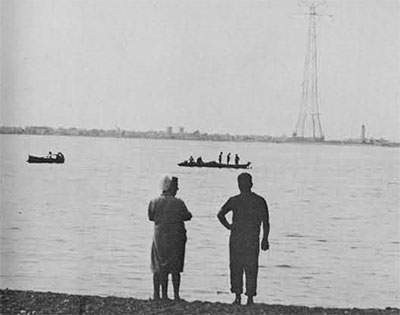
Moving up the slope and along the axis of the ship we excavated the bow area. We knew from the sketch plan that we were near the bow, for, from this area a huge, 1000-kilo lead anchor stock was removed, cut up, and sold as scrap. Two additional lead stocks of smaller dimensions but with Greek or Phoenician inscriptions met the same fate at the hands of the looters. At the extreme edge of this area we uncovered four large lead bars. Trapezoidal in section, they were somehow used in the anchors’ construction. Nearby, we excavated two bronze anchor fluke-tip shields. The flukes were originally made of wood whose pointed tips were sheathed in bronze to protect them from the rocky sea bottom. The wood was still preserved within the bronze sheathing. A third one was recovered by the police and adds additional proof for the use of more than one anchor on the ship. We now have enough evidence to reconstruct an entire anchor of the fifth century B.C.
Little of the wooden hull survived. Tens of thousands of wood-boring worm casings that littered the bottom were evidence enough that the hull had been there. The shapeless wood fragments that did survive clearly indicated the use of the mortise-and-tenon construction technique now so well known from the Kyrenia ship excavation and elsewhere. Fragments of lead sheathing from the hull illustrate the earliest known use of a technique, which continued through Roman times, to protect the ship’s hull from the wood-boring worm. By comparing the remains of large copper nails, both straight and clenched, with those from the Kyrenia ship, we determined that our ship was somewhat larger, perhaps as much as twenty-five meters long.

In addition to the amphora cargo the ship also carried about fifteen loaf-shaped lead ingots, all but two of which were removed from the wreck and destroyed. They contained numerous foundry stamps and would certainly have provided much new evidence for the metal trade of this period had they survived. The many bronze statue fragments suggest that at least two lifesize statues were on board, either being shipped to their purchaser(s) or perhaps representing booty from some recently plundered city. On the other hand, since our merchantman was dealing in metals, the bronze statue fragments may simply have been part of a junk-metal cargo on its way to the foundry to be melted down and reused. Such was often the fate of bronze statues in antiquity. When the fragments are cleaned and restored, we will hopefully be able to tell if we are dealing with two complete statues or a group of unconnected fragments.
At the conclusion of any ship excavation the obvious question posed is why did it sink. Unlike the ships that met their untimely ends on the reef at Yassi Ada, Turkey, we have no obvious clues. Not enough of the ship was preserved to allow much speculation. The five hundred grams of silver nuggets found in the cabin area perhaps indicate the sudden departure over the side by the captain and his crew. So sudden, in fact, he forgot to take along his purse. The combination of currents and storm is the most likely explanation for the sinking of the ship. The reputation for disaster that the Straits have held since Odysseus sailed their treacherous waters is warning enough that the ancient mariner had serious difficulties in sailing along these shores.
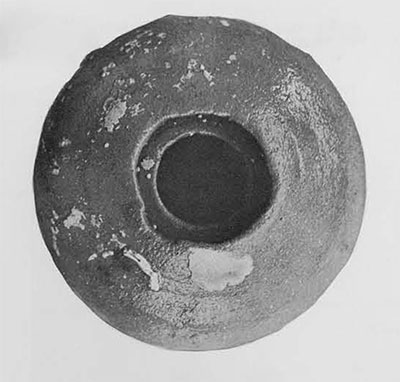
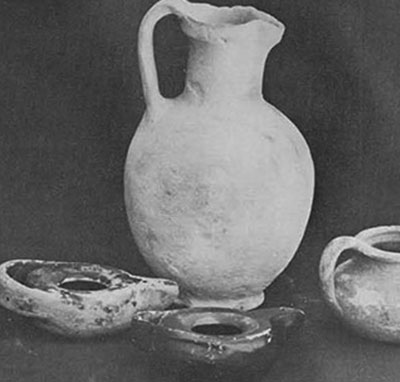
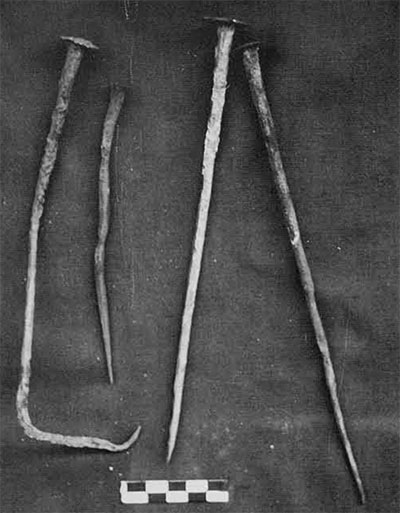
From our excavation and even more so from the Kyrenia excavation, it is now clear that Mediterranean trading ships in the Classical and Hellenistic periods normally carried mixed cargoes over long distances. It is likely that these merchantmen picked up and discharged cargoes as they sailed, no doubt along with occasional passengers. Remains of a cargo, therefore, are nearly as good as a written itinerary of a ship’s route. We now also know that ships were constructed in a well-known technique which hardly varied from one end of the Mediterranean to the other. Even the crew’s equipment was similarly uniform over long periods of time from one area to another. It is only through underwater excavation that this type of information can continue to be made available.
The tragedy of our excavation was that we were only able to “pick up the pieces” overlooked by the looters. That this would have been one of the most exciting and important finds of underwater archaeology is quite clear from what we know to have been sold and destroyed and what was confiscated from the looters through the quick action of Prof. Foti and the local police. Time is rapidly running out. Many underwater sites in workable depths are already completely pillaged. Even those in dangerous and remote areas are being destroyed. Without a concerted effort, both by the countries whose historical monuments are being destroyed and those to which the material is being sold, little can be done to save what is left. The choice is clear. Action must be taken now, for in a few short years there will be nothing left on which to act!
